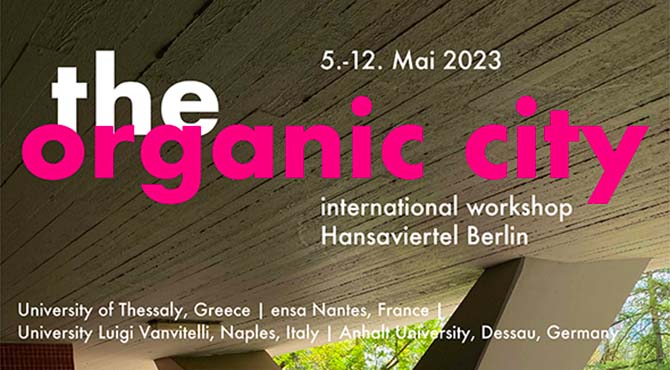Organic City_Hansaviertel Berlin (Interbau 1957)
5 – 12 May 2023
A joint workshop of the University of Thessaly, Volos, Greece, ensa Nantes, Nantes, France, University Luigi Vanvitelli, Napoli, Italy, Anhalt University, Dessau, Germany

The workshop project, Organic City_Hansaviertel Berlin (Interbau 1957), connected with the concept of organic architecture and design in order to develop new perspectives of interdisciplinary conceptual learning. The idea of organic architecture and design proved to be one of the most fundamental factors in the formation of the modern movement and the concept of modernity. Frank Lloyd Wright had first used the term organic architecture, declaring it the modern ideal and the much-needed teaching for understanding life as a whole (F. LL. Wright, 1954, The Natural House).
Over time, it became clear that maintaining an organic relationship with nature was necessary to cultivate a sustainable and humane society, create a livable environment, and develop healthy cities. Organic design, which reflected and organised the interaction between the natural and the human, offered a perspective in a world characterised by radical change, crisis, conflict, and war, resulting in environmental damage. This world needed a new strategy of Organic design.
In 1977, only 20 years after Interbau 1957, Oswald Mathias Ungers and Rem Koolhaas collaborated on the critical manifesto The City in the City. Berlin a Green Archipelago. They introduced the notion of an archipelago in conceptual urban design thinking. By 2023, the concept of the city as an archipelago may have become a part of our collective unconscious. It is likely that Hansaviertel will be one of the islands in the Berlin Archipelago.
The international workshop The Organic City intended to consider new strategies for reading, understanding, and interpreting the principles of organic architecture and design as a driving force in the development of societies towards culture and civilization. The workshop provided a platform for design collaboration and discourse to a group of 35 students from four European universities who worked in five transnational teams.
Credits for the students images: Bal Balachandran Vaishak, El-gamla Iman, Farina Ilaria, Grafakou Sotiria-Afrodite, Sofia Boutsouki, Fotis Moutzouris, Gina Gadomski, Lisa-Marie Kauruff, Maddalena Fontana, Mike Kaisaris, Artemis, Duygu, Erdem, Giuseppe and Marion
Photo Credits: Cornelia Boettner
Studio coordinators: Vaso Trova, (University of Thessaly), Corrado di Domenico (University Luigi Vanvitelli), Jean-Marie Beslou (Ensa Nantes), Johannes Kalvelage (Hochschule Anhalt), Cornelia Böttner (Hochschule Anhalt), Like Biljsma (Rotterdam_PBL, Netherlands Environmental Assessment Agency)

